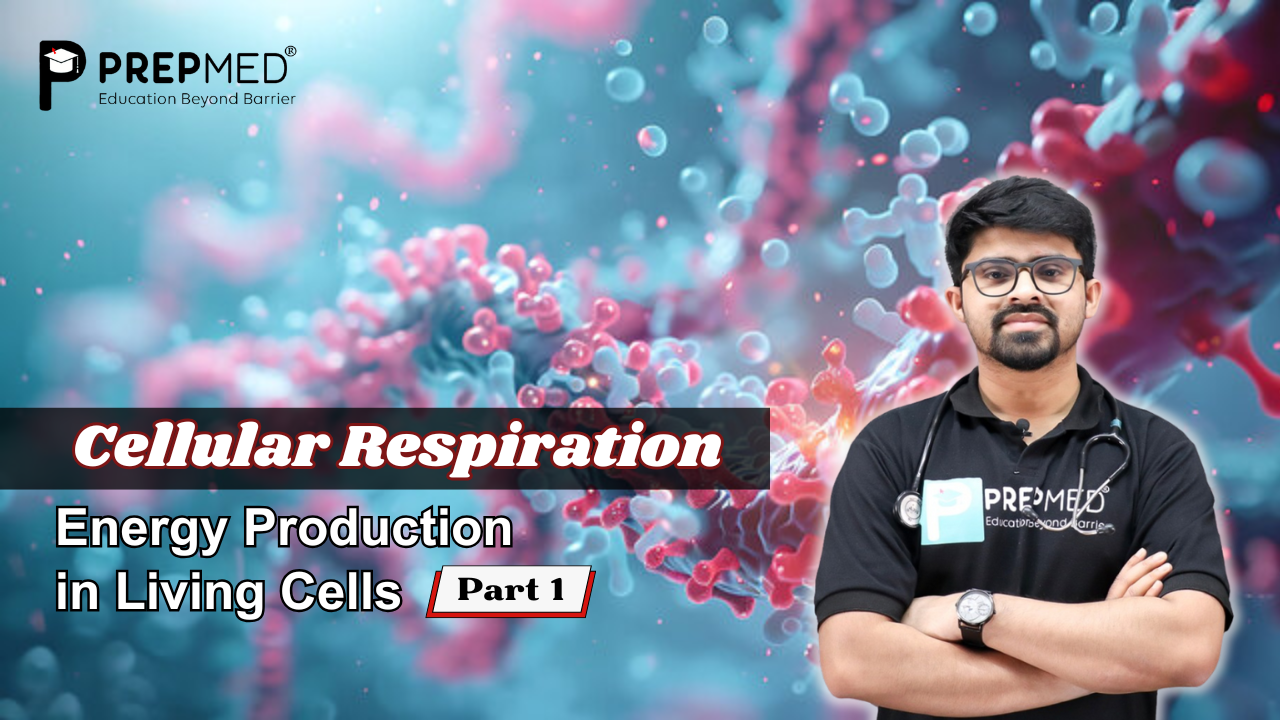January 06, 2025
Cellular Respiration: Energy Production in Living Cells part 1
Respiration is one of the most basic biochemical processes common to all forms of life and also plants. In contrast to photosynthesis where energy is utilized to synthesize food in plants, respiration involves the use of energy to break down food (glucose) in plants for growth, development, and sustenance. This blog will aim at providing an insight into the different aspects that are involved in plant respiration starting with the general aspects of cellular respiration. Two main categories of respiration are aerobic and anaerobic the only difference between them is that the former takes place in the presence of oxygen while the latter does not.
The article under discussion will explain how plants are able to use mitochondria, the energy center of the cell, to metabolize stored energy into usable forms. It will also include how the respiratory substrates, including glucose, are metabolised through the various biochemical pathways like glycolysis, the Krebs cycle, and the electron transport chain.
Also, we will consider the contribution of respiration in different plant organs such as roots, stems, and leaves and the effects of certain factors such as temperature and oxygen availability on the rate of respiration. Last but not least, you will also understand the importance of respiration for the growth of plants, relation with photosynthesis, and harmony between both processes for the welfare of plants. This understanding is, therefore, very essential in improving the practice of agriculture leading to improvement of crop production yields.
How do plants breathe?
The mode of breathing or gas exchange differs from one plant to another, unlike what you find in animals. In respiration, plants require oxygen while giving out carbon dioxide. Stomata and lenticels are the organs through which gas exchange takes place but a limited amount of gases pass through these regions from one part of the plant to the other.
Molecules do not require substantial gases for exchange or several needs in order to go through respiration. They only enter into gaseous exchange most of the time when they are involved in photosynthesis. Because oxygen is produced along with energy in photosynthesis, this element does not need to be imported from somewhere in the world.
The synthesis of biomolecules and other biological processes can utilize 50% of the total energy produced during respiration. It is possible to take up the carbon which is produced during respiration and help in the synthesis or build-up of other chemicals present in the cell.
During the process of respiration in plants, oxygen is utilized and water, carbon dioxide, and energy are released as a byproduct. The equation can be represented as:
C6H12O6+6O2 → 6CO2+6H2O+Energy
What do you understand by the term “Glycolysis?”
Glycolysis is the breaking down of glucose into two molecules of pyruvate; a three carbon compound occurs in the cytoplasm. It consists of 10 enzyme-catalyzed reactions, divided into two phases: Preparatory phase (also known as investment phase) and Pay-off phase.
It is the primary phase of respiration, both the anaerobic and aerobic respiration. It is a series of consecutive enzymatic reactions that produce pyruvic acid after oxidation of glucose. This process is commonly called the EMP pathway, for the first letters of the biologists who discovered it, namely Gustav Embden, Otto Meyerhof, and J. Parnas.
The steps of glycolysis can be explained in the following steps:
1. Phosphorylation of Glucose (Preparatory Phase)
- Enzyme: Hexokinase
- Glucose (6C) is phosphorylated using one molecule of ATP to form Glucose-6-phosphate (G6P).
2. Isomerization of Glucose-6-phosphate
- Enzyme: Phosphoglucose isomerase
- Glucose-6-phosphate is converted into Fructose-6-phosphate (F6P) by isomerization.
3. Phosphorylation of Fructose-6-phosphate
- Enzyme: Phosphofructokinase (PFK)
- Fructose-6-phosphate is phosphorylated using one more ATP molecule to form Fructose-1,6-bisphosphate (F1,6BP).
4. Cleavage of Fructose-1,6-bisphosphate
- Enzyme: Aldolase
- The six-carbon fructose-1,6-bisphosphate is split into two three-carbon molecules: Dihydroxyacetone phosphate (DHAP) and Glyceraldehyde-3-phosphate (G3P).
5. Isomerization of Dihydroxyacetone phosphate
- Enzyme: Triose phosphate isomerase
- DHAP is then converted into 2 molecules of Glyceraldehyde-3-phosphate (G3P).
6. Oxidation of Glyceraldehyde-3-phosphate
- Enzyme: Glyceraldehyde-3-phosphate dehydrogenase
- Each G3P molecule is oxidized, producing 1,3-bisphosphoglycerate (1,3-BPG) and reducing NAD+ to NADH.
7. ATP Synthesis (Substrate-level phosphorylation)
- Enzyme: Glyceraldehyde-3-phosphate dehydrogenase
- Each G3P molecule is oxidized, producing 1,3-bisphosphoglycerate (1,3-BPG) and reducing NAD+ to NADH.
8. Conversion of 3-Phosphoglycerate to 2-Phosphoglycerate
- Enzyme: Phosphoglycerate mutase
- 3PG is converted into 2-phosphoglycerate (2PG).
9. Dehydration of 2-Phosphoglycerate
- Enzyme: Enolase
- 2PG undergoes dehydration, losing a water molecule, forming two phosphoenolpyruvate (PEP).
10. ATP Synthesis and Formation of Pyruvic acid
- Enzyme: Pyruvate kinase
- PEP donates its high-energy phosphate group to ADP, forming ATP and producing pyruvate.
NOTE: Different cells manage pyruvic acid produced by glycolysis in three main ways. They include Lactic Acid Fermentation, Alcoholic Fermentation, and Aerobic respiration. Fermentation takes place in absence of oxygen in many of the prokaryotic organisms as well as the eukaryotic unicellular organisms. But in order to achieve the breakdown of glucose into CO2 and H2O, organisms use Krebs’ cycle which is known as aerobic respiration. This requires O2 supply.
Explain the process of Fermentation
The incomplete oxidation of glucose in processes like fermentation, by yeast for instance, occurs at anaerobic conditions through sets of reactions through which pyruvic acid is turned to CO2 and ethanol. These reactions are catalysed by the enzymes pyruvic acid decarboxylase and alcohol dehydrogenase.
It is worth noting that some organisms such as bacteria produce lactic acid from pyruvic acid. In animal cells also, similar to the working muscles when there is deficiency of oxygen for cellular respiration pyruvic acid is converted to lactic acid by lactate dehydrogenase. The reducing agent is NADH+H+. Alcoholic fermentation and lactic acid fermentation are the two different types of fermentation.
What do you mean by alcoholic fermentation?
Alcoholic fermentation is an anaerobic process in which glucose or other sugars are fermented into alcohol (ethanol) and carbon dioxide as well as a little ATP. It takes place in the cytoplasm of the cells mainly in the yeast and some bacteria when oxygen is not present for aerobic respiration. This process is utilized by microorganisms such as yeast to generate energy, especially when oxygen is not available.
The process can be explained in these steps:
Glycolysis:
Glucose (a six-carbon sugar) is broken down in the cytoplasm to form two molecules of pyruvate through a series of reactions, with the production of 2 ATP and 2 NADH.
This is the same initial step as in aerobic respiration, but since oxygen is absent, the pyruvate will not enter the mitochondria for further breakdown.
Decarboxylation of Pyruvate:
The two molecules of pyruvate produced during glycolysis are converted into acetaldehyde (a two-carbon molecule) and carbon dioxide (CO₂) is released.
Enzyme: Pyruvate decarboxylase.
Reduction of Acetaldehyde:
Acetaldehyde is then reduced to ethanol (alcohol) by accepting electrons from NADH, which is oxidized to NAD+.
This step regenerates NAD+, which is crucial for allowing glycolysis to continue, as NAD+ is required to oxidize glucose in the first step of glycolysis.
Enzyme: Alcohol dehydrogenase.






